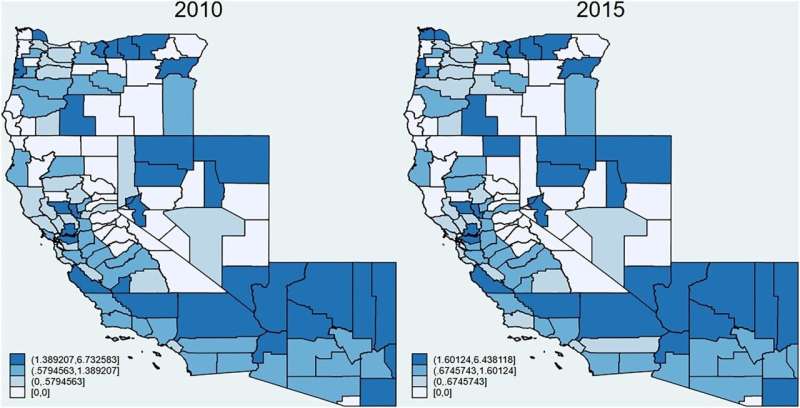This article has been reviewed according to Science X's editorial process and policies. Editors have highlighted the following attributes while ensuring the content's credibility:
fact-checked
trusted source
proofread
Failings of California's Cap and Trade Program revealed in new analysis

California's Cap and Trade Program does not achieve its twin goal of reducing carbon emissions while allowing for economic growth, according to a pioneering new study.
Professor Enrico Onali (Head of Finance and Accounting at the University of Exeter Business School) and Dr. Danilo Mascia (Associate Professor, University of Leeds) are the first to analyze California's signature Cap and Trade Program from a regional perspective in a new article published in Regional Studies.
The Cap and Trade Program (CATP) was introduced in 2013 to reduce carbon emissions to 40% below 1990 levels by 2030. The program sets limits on the amount of carbon that businesses in California can emit and introduces a system of carbon credits, which polluters that exceed the carbon emissions limit can buy from the government via an auction process as well as trade with other firms.
A large reduction in emissions can occur without negatively impacting economic growth if higher growth from "green" industries offset lower growth from polluting industries—a theory known as "decoupling".
The researchers studied the real short-term effects of the CATP by collecting county-level data on GDP and population from the Bureau of Economic Analysis and retrieving data on facility-level emissions from the Greenhouse Gas Reporting Program (GHGRP), accessible via the Environmental Protection Agency website.
Their analysis compared county-level economic growth and county-level and facility-level emissions in California with those in other US counties from 2010 to 2015.
The researchers found no significant differences in local economic growth in California counties compared to bordering counties in the neighboring states of Oregon, Nevada and Arizona after the implementation of the CATP.
However, while this finding was encouraging, the authors found no evidence of "decoupling", with the impact of CATP on local emissions levels in areas where it was in force negligible compared to unregulated regions.
The authors suggest the failure to reduce emissions could result from a poorly designed allowance-allocation system: if the cap on emissions is not low enough relative to business-as-usual emissions, the impact on local emissions relative to unregulated regions might be negligible.
Looking at the potential underlying mechanisms behind the findings, the researchers ruled out the possibility of 'emissions leakage' in the form of businesses transferring their emissions from the regulated state to unregulated regions.
However, their regional analysis was key to identifying a novel loophole: multi-state businesses adjusting their market share in facilities within the regulated areas, thus decreasing their accountability for emissions.
While this might not change the overall level of emissions, the researchers point out that it could lead to technological and other operational shifts that, in turn, could impact that region's local economy.
The authors also highlight the importance of using a regional approach and a methodology that focuses on regional contiguity and spatial distance between regulated and unregulated regions to estimate the impact of climate regulations more precisely.
Professor Onali said, "Our research reveals some of the unintended consequences of these regulations that only a regional perspective can bring to light. We hope it can provide important lessons for regional policymakers as our results suggest that regional cap-and-trade programs could be successful in countries other than the United States as long as the cap is binding."
Such a regional approach can also help to understand the potential impact of lobbying from polluting industries, Professor Onali said, adding: "There is a trade-off between a hard stance against lobbying, which might lead to relocation of factories in other regions, and a more sympathetic behavior towards emitters, which might undermine the societal goal to curb emissions."
The study is published in the journal Regional Studies.
More information: Danilo V. Mascia et al, Keep calm and carry on emitting: cap-and-trade rules, local emissions and growth, Regional Studies (2023). DOI: 10.1080/00343404.2023.2194315
Provided by University of Exeter





















